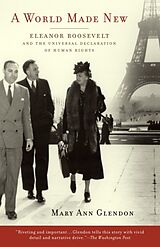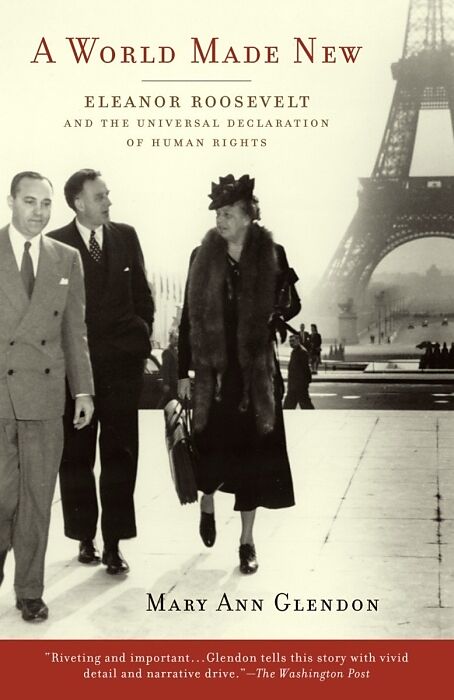World Made New
Einband:
Broschiert
EAN:
9780375760464
Untertitel:
Eleanor Roosevelt and the Universal Declaration of Human Rights
Genre:
Geschichte
Autor:
Mary Ann Glendon
Herausgeber:
Random House Publishing Group
Anzahl Seiten:
342
Erscheinungsdatum:
11.06.2002
ISBN:
0375760466
Unafraid to speak her mind and famously tenacious in her convictions, Eleanor Roosevelt was still mourning the death of FDR when she was asked by President Truman to lead a controversial commission, under the auspices of the newly formed United Nations, to forge the world's first international bill of rights. A World Made New is the dramatic and inspiring story of the remarkable group of men and women from around the world who participated in this historic achievement and gave us the founding document of the modern human rights movement. Spurred on by the horrors of the Second World War and working against the clock in the brief window of hope between the armistice and the Cold War, they grappled together to articulate a new vision of the rights that every man and woman in every country around the world should share, regardless of their culture or religion. A landmark work of narrative history based in part on diaries and letters to which Mary Ann Glendon, an award-winning professor of law at Harvard University, was given exclusive access, A World Made New is the first book devoted to this crucial turning point in Eleanor Roosevelt's life, and in world history. Finalist for the Robert F. Kennedy Book Award
#8220;Riveting and important...Glendon tells this story with vivid detail and narrative drive.”
—The Washington Post
“Vividly written and evenhanded, A World Made New is an important, potentially galvanizing book, and in this frightful, ferocious time, marked by war and agony, it is urgent reading.”
—Blanche Wiesen Cook, Los Angeles Times
“A terrific story, and Glendon tells it well....An illuminating and unexpectedly timely book.”
—The New Republic
“The definitive account...Anybody concerned with the question of human rights in today’s world will need to read it and refer to it.”
—The New York Times Book Review
Autorentext
Mary Ann Glendon is Learned Hand Professor of Law at Harvard University. She led the Vatican delegation to the Beijing Women's Rights conference in 1995, the first woman ever to lead a Vatican delegation, and has been featured on Bill Moyers's World of Ideas. She is the author of Rights Talk; A Nation under Lawyers; Comparative Legal Traditions (a classic textbook on international law); Abortion and Divorce in Western Law, winner of the Scribes Book Award; and The Transformation of Family Law, winner of the Order of the Coif Prize, the legal academy's highest award for scholarship. She lives in Chestnut Hill, Massachusetts.
Leseprobe
Politics, it has been said, is “the arena where conscience and power meet, and will be meeting until the end of time.”1
Conscience so often fares poorly in such encounters that we celebrate the occasions when Power gives her more than a tip of the hat. In April 1945, as delegates from fifty lands gathered in San Francisco for the United Nations founding conference, Power was much on display. Battleships leaving the Pacific harbor with men and matériel were a grim reminder that the war with Japan was still raging. The tides of war in Europe, however, had turned in favor of the Allies, and the “Big Three” (Britain, the Soviet Union, and the United States) had begun jockeying for the positions they would hold in the new world order. As part of their planning for the postwar era, the Allies invited to the San Francisco conclave all states that had declared war on Germany and Japan by March 1, 1945.
The Allied leaders had agreed in principle on the need for an international organization to prevent future aggression, assure the stability of frontiers, and provide a means for resolving disputes among nations, but the most vigorous supporter of the idea was Franklin Roosevelt. The American president was mindful that the failure of the first such organization, the League of Nations, was due in no small measure to President Woodrow Wilson’s inability to convince the Senate to ratify the treaty establishing it. A driving force behind the League’s formation after World War I, Wilson had been bitterly disappointed.
To prevent a repetition of that debacle, Roosevelt had begun speaking to the American people about his hopes for a new world organization during the war. “Nations will learn to work together,” he insisted, “only by actually working together.”
In a radio address on Christmas Eve 1943, he emphasized that the main purpose of such an organization would be to keep the peace. The United States had no interest, he said, in Allied domination over other nations: “The doctrine that the strong shall dominate the weak is the doctrine of our enemies–and we reject it.”3
Now, with the confidence born of approaching victory, Roosevelt believed the time had come to make up for the mistakes of the last peace. Shortly after his inauguration in January 1945, he told Congress of his hopes to replace the old international system of “exclusive alliances and spheres of influence” with a “universal organization in which all peace-loving nations will finally have a chance to join.”4
Eleanor Roosevelt had long shared those hopes. When her husband asked her to accompany him to the opening session of the UN founding conference in April, and on a trip to England and the continent in May, she was delighted–not least because his enthusiasm allayed her growing anxiety about his health. Labor Secretary Frances Perkins had objected that a trip to the war zone would be too dangerous, but the president replied that he expected the war to be over by then. He had long looked forward, he told Perkins, to a victory tour with the First Lady at his side: “Eleanor’s visit [to England] in wartime was a great success. I mean a success for her and for me so that we understood more about their problems. . . . I told Eleanor to order her clothes and get some fine things so that she will make a really handsome appearance.”5
With spring flowers in bloom and war’s end at last in sight, an exuberant president began to prepare for the San Francisco conference.
The features of the future UN that were of most interest to the Great Powers had been settled already at two much more exclusive meetings. In the summer and fall of 1944, representatives of Britain, China, the United States, and the USSR had met at Dumbarton Oaks to do preparatory work on what would become the UN Charter. One month earlier, at Bretton Woods in New Hampshire, the Allies had established the main institutions of the postwar economic order–the International Monetary Fund and the International Bank for Reconstruction and Development (the World Bank).
Determined to avoid Wilson’s main error, Roosevelt actively courted Republican support for the United Nations. When the time came to choose representatives for San Francisco, he made a point to include prominent GOP leaders: former Minnesota Governor Harold Stassen, future Secretary of State John Foster Dulles, and Senator Arthur Vandenberg, the ranking minority member of the Senate Foreign Relations Committee.
The Soviets went along with the project, but without much enthusiasm. Their chief concern for the immediate postwar period was to protect the frontiers of the motherland from renewed aggression. On the eve of the Normandy invasion, according to former Yugoslav Communist Party official Milovan Djilas, Stalin told Djilas: “Perhaps you think that just because we are the allies of the English we have forgotten who they are and who Churchill is. They find nothing sweeter than to trick their allies. . . . Churchill is the kind who, if you don’t watch him, will slip a kopeck out of your pocket. . . . Roosevelt is not like that. He dip…

Leider konnten wir für diesen Artikel keine Preise ermitteln ...
billigbuch.ch sucht jetzt für Sie die besten Angebote ...
Die aktuellen Verkaufspreise von 6 Onlineshops werden in Realtime abgefragt.
Sie können das gewünschte Produkt anschliessend direkt beim Anbieter Ihrer Wahl bestellen.
Loading...
Die aktuellen Verkaufspreise von 6 Onlineshops werden in Realtime abgefragt.
Sie können das gewünschte Produkt anschliessend direkt beim Anbieter Ihrer Wahl bestellen.
| # | Onlineshop | Preis CHF | Versand CHF | Total CHF | ||
|---|---|---|---|---|---|---|
| 1 | Seller | 0.00 | 0.00 | 0.00 |
